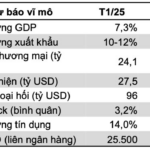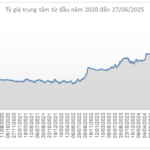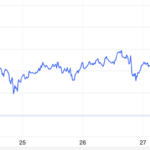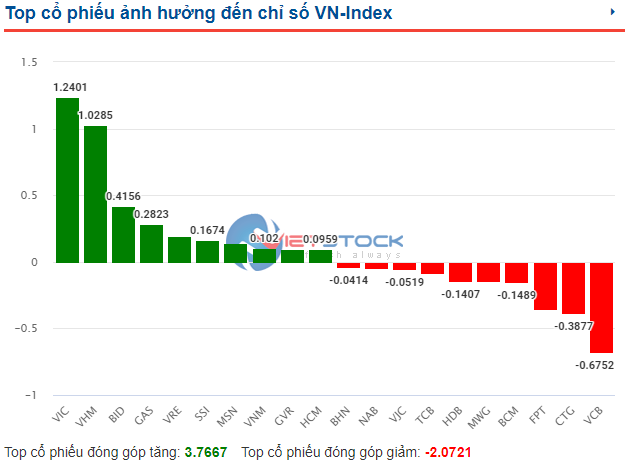Inflation Dynamics and Outlook for 2025: Vietnam’s Economic Story
While ranking second in the “ideal” pentagon objective (high growth, low inflation, current account surplus, low unemployment, and environmental protection and improvement); for developing countries with transitioning economies, the fluctuations of inflation deserve keen attention.
Vietnam’s inflation has undergone several periods of variation. During the era of centralized planning and subsidies, inflation remained relatively low. This low level was latent, and when it rose, it did so at a “galloping” pace, reaching double-digit rates until the early 1990s when the economy transitioned to a market economy.
Inflation rose significantly to double digits again in 2010-2011 during the global financial crisis and economic recession that started in late 2008 and lasted longer in Vietnam. Since 2014, Vietnam’s inflation has been kept at a low level (Figure 1).
Vietnam’s average CPI (inflation) over the years has been assessed from different perspectives. From 2014 onwards, inflation has been controlled according to the target, spanning a period of 11 years, the longest compared to previous periods.
INFLATION DYNAMICS
From 2014 to 2024, the average annual CPI increase was 2.91%, significantly lower than the target of 4%. Some years, like 2015 and 2021, witnessed notably lower increases.
In recent years, Vietnam’s CPI has also been considerably lower than that of many other countries (the US, EU, etc.), which experienced their highest inflation rates in decades, far surpassing their targeted levels.
For over a decade, Vietnam’s CPI has generally grown at a slower pace than GDP: in 2014, CPI was 4.09% compared to a GDP growth of 6.42%; in 2015, CPI was 0.63% against a 6.99% GDP growth; in 2016, CPI was 2.66% while GDP grew by 6.69%; in 2017, CPI was 3.53% with a GDP growth of 6.94%; in 2018, CPI was 3.54% and GDP expanded by 7.47%; in 2019, CPI was 2.79% as GDP grew by 7.36%; in 2021, CPI was 1.84% with a GDP growth of 2.56%; in 2022, CPI was 3.15% while GDP increased by 8.12%; in 2023, CPI was 3.25% and GDP grew by 5.05%; and in 2024, CPI was 3.63% with a GDP growth of 7.09%. Only in 2020, due to the COVID-19 pandemic, did CPI rise higher than GDP growth (3.53% compared to 2.87%).
The inflation dynamics of 2024 can be analyzed through various commodity and service groups. Out of the 11 primary consumer goods and service groups, one group, postal and telecommunications, experienced a price decrease of 1.02%. Five groups witnessed price increases lower than the overall average: equipment and utensils by 1.07%; clothing by 1.4%; culture, entertainment, and tourism by 1.97%; beverages and tobacco by 2.42%; and transportation by 0.76%. This was among the factors that helped alleviate inflationary pressures.
On the other hand, five groups experienced price increases higher than the overall average: medicine and medical services by 7.16%; other goods and services by 6.56%; education by 5.37%; housing and construction materials by 5.2%; and food and dining services by 4.03%.
However, the weight of some of these groups in total consumption is relatively low, such as other goods and services (3.3%), beverages and tobacco (3.59%), culture, entertainment, and tourism (4.29%), etc.
INFLUENCING FACTORS
Several factors influenced inflation in 2024.
Firstly, the relationship between production and GDP utilization, also known as the fundamental factor, plays a role. When calculated in real terms, domestic utilization, including asset accumulation and final consumption, showed the following ratios of total asset accumulation and final consumption to GDP in recent years (Figure 2).
The scale of domestic utilization indicators is lower than GDP, indicating that domestic demand is weaker than domestic supply. This is due to continuous and substantial goods trade surpluses (in 2016, it was 1,602.4 million USD, 1,903.3 million USD in 2017, 6,455.2 million USD in 2018, 10,570.7 million USD in 2019, 19,838 million USD in 2020, 3,058 million USD in 2021, 12,402.2 million USD in 2023, 28,207.5 million USD in 2023, and 24,768 million USD in 2024). These are essential factors related to supply and demand in the domestic market and represent the fundamental, comprehensive nature of inflation.
The services trade deficit narrowed. In 2024, services exports reached 23,851 million USD, a 17.7% increase, while services imports were 36,193 million USD, a 24.4% increase. Although imports had a larger scale and growth rate than exports, resulting in a services trade deficit of 12,342 million USD, higher than the previous year’s deficit of 8,828 million USD, Vietnam still maintained an overall surplus in goods and services trade.
When calculated in comparative prices, the growth rate of total asset accumulation and final consumption in recent years is as follows (Figure 3).
In most recent years, the growth rate of domestic demand has been lower than the growth rate of domestic supply (GDP). The growth rate of total retail goods sales and consumption services revenue in real terms (9%) would be lower if deflated and would be lower than the GDP growth rate (5.9% compared to 7.09%). The ratio of total retail goods sales and consumption services revenue to GDP in 2024 was 55.5%, lower than the corresponding ratio in 2023 (56.8%).
These indicators demonstrate that total consumer demand remains subdued. The scale and growth rate of domestic demand have been lower than domestic supply, contributing to reduced inflationary pressure and facilitating inflation control according to the set target.
E-commerce, especially the recent emergence of Chinese e-commerce platforms, has also contributed to slower inflation.
Secondly, cost-push factors come into play due to fluctuations in various types of input prices for CPI (Figure 4).
Import prices increased significantly in 2021 (5.49%) and even more so in 2022 (8.56%), leading to imported inflation. However, in 2023, there was a substantial decrease (-4.73%), followed by another deep decline in 2024, causing domestic input prices, especially industrial production prices, to rise modestly, reducing inflationary pressure.
Prices of raw materials, fuel, and other consumables for domestic production increased sharply in 2021 (5.51%) and 2022 (6.79%). In 2023, there was a decrease (-1.88%), and although there was an increase in 2024, it was still lower than domestic production and service prices, exerting no significant pressure on CPI.
Production prices did not increase significantly, and even for manufacturing industries, the increase was minimal (0.19%), posing no substantial pressure on CPI. However, transportation and warehousing prices rose notably, mainly due to air transportation prices (91.16%).
Thirdly, fiscal and monetary factors are both latent and direct influences, and they manifest in price movements.
On the fiscal front, several notable impacts are worth mentioning. The ratio of budget revenue to GDP has been on a downward trend. This ratio was 20.43% in 2028, fell to 20.16% in 2019, and continued to decrease to 18.78% in 2020, 18.76% in 2021, 19.01% in 2022, 16.81% in 2023, and is estimated at 17.7% in 2024 (higher than in 2023).
The budget revenue-to-GDP ratio in 2024 is higher than the previous year but remains lower than the ratios from 2022 and earlier. This reflects improved economic growth efficiency and embodies the spirit of “easing the burden on the people” to facilitate base salary increases and prepare for salary adjustments during organizational streamlining.
The ratio of budget expenditure to GDP has also decreased and is lower than in previous years (20.48% in 2018, 19.81% in 2019, 21.25% in 2020, 20.12% in 2021, 18.20% in 2022, 20.44% in 2023, and 15.9% in 2024). This is partly due to efficient management practices, contributing to a reduced budget deficit in 2023 and a surplus in 2024.
A budget deficit is a latent factor for domestic inflation and increases public and foreign debt, while a surplus helps control inflation and limits the rise in public and foreign debt.
Monetary factors have a direct impact on keeping inflation low. Credit growth in 2024 was higher than the corresponding figure in 2023 (13.82% compared to 11.48%). Although it has accelerated in recent months, the overall rate remains lower than the target (13.82% versus 14%), exerting no significant pressure on CPI.
A significant amount of money was invested in virtual currencies, real estate, and gold when prices in these markets rose sharply. The recent surge in virtual currency prices (bitcoin reaching an all-time high of 100,000 USD) also attracted substantial funds, reducing inflationary pressure at this point. However, caution is needed when this money returns to the consumer goods and services market.
The velocity of money circulation remains slow, as the ratio of total means of payment to GDP (in real terms) is still below 1, even lower than before.
Psychological factors, although not economic in nature, can significantly influence inflation control and, in some cases, have a more potent effect than economic factors.
The VND/USD exchange rate appreciation in 2024 (4.91%) was the highest since 2012 (averaging 0.13% annually from 2012 to 2019 and 0.74% from 2020 to 2023). While this made imported goods more expensive in VND terms, it reduced their cost in USD by 1.94%. A stronger VND benefits exports and makes imports more costly, further contributing to a substantial goods trade surplus.
The gold price increase (28.64%) was the highest since 2021 (8.67% in 2021, 5.74% in 2022, and 4.16% in 2023). This was partly due to gold’s upward cycle, increased purchases by China and other countries, and monopoly influences.
Recently, due to regulatory interventions and global market influences, domestic gold prices have declined, narrowing the gap between domestic and world gold prices significantly (from a peak of 18-20 million VND/tael to 4 million VND/tael). Gold prices fluctuate, but they may enter a downward cycle in the coming years after five years of substantial increases.
EXPECTATIONS AND SOLUTIONS FOR 2025
The inflation target for 2025 is set at approximately 4.5%, slightly higher than the 2024 level. There are high expectations for 2025 to be the 12th consecutive year of achieving the inflation target, and these expectations stem from various factors.
Fundamentally, the relationship between total supply and demand in the domestic market remains in a state where supply exceeds demand.
Regarding supply, the GDP growth target for 2025 is set at 8%, which is relatively high compared to many previous years and the average annual growth rate in previous periods. High growth demands higher investment and consumption, implying increased inflationary pressure. However, it also increases the supply of goods and services, contributing to reduced inflationary pressure.
Demand will also increase due to higher accumulation and investment to achieve the main objectives of the five-year plan, implement the established planning, and invest in key national projects. Final consumption will rise due to adjustments in retirement pensions and civil servant salaries in 2024. However, in 2025, civil servant salaries will not be adjusted, and the increase will only apply to specific groups, resulting in a slower growth rate of final consumption compared to GDP growth.
In 2025, Vietnam is expected to achieve a goods trade surplus for the tenth consecutive year, with a narrowing services trade deficit, resulting in an overall surplus in goods and services trade. A goods trade surplus, or a positive trade balance, is not just an essential component of the macroeconomic balance but also an indicator and manifestation of domestic production exceeding domestic demand.
Regarding cost-push factors, although export and import prices may rise due to potential US import tariff increases, a stronger USD against other currencies, or rising virtual currency prices (as declared by the newly elected US president), they are not expected to surpass CPI.
Fiscal and monetary factors will undergo certain adjustments to achieve the higher economic growth target. Still, the trends in budget revenue and expenditure, the budget deficit, and monetary and credit factors are not expected to undergo significant changes, so their impact on inflation will be limited. The flow of money into real estate, virtual currencies, and other investments will increase, temporarily reducing pressure on the consumer goods and services market and inflation.
Psychological factors will continue to influence behavior, and the general tendency will be towards “saving for a rainy day,” having just emerged from a period of “tightening our belts.” Therefore, consumption and total demand will remain subdued compared to GDP growth.
To achieve the target and expectations for 2025, several solutions should be considered.
Firstly, it is crucial to achieve and surpass the economic growth target to increase the supply of goods and services, which is the most critical factor in ensuring a balance between supply and demand for goods and services in the domestic market. It is also essential to manage total demand carefully, especially investment, in terms of quantity, source, and, most importantly, efficiency.
Secondly, caution is necessary in loosening fiscal and monetary policies to avoid creating inflationary pressure.
Thirdly, regarding cost-push factors, extreme caution is needed in adjusting the exchange rate to prevent a significant increase in import prices in VND terms and avoid providing a pretext for countries to accuse Vietnam of “currency manipulation,” leading to adverse effects. Careful consideration is also required when adjusting the prices of services such as gasoline, school fees, electricity, and water.
https://postenp.phaha.vn/tap-chi-kinh-te-viet-nam/detail/1262
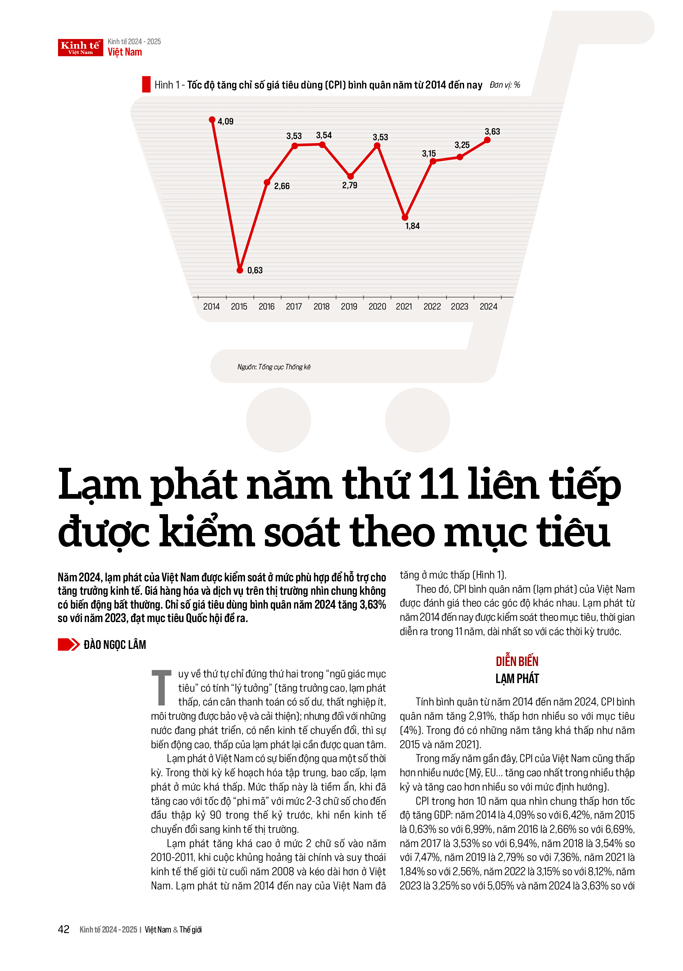
Is All This Money Being Spent in the Right Places?
“Vietnam requires a more flexible and efficient mechanism to direct funds to where they are needed most. The first step is to untangle the bottleneck of public investment disbursement, followed by redirecting credit flows. Instead of fueling speculative channels, the focus should be on prioritizing manufacturing, green technology, and social housing.”
‘Heated’ Dialogue with the Prime Minister: The Laughter and Tears of Personal Income Tax
“In a recent development, Prime Minister Pham Minh Chinh adeptly addressed a ‘burning’ question posed by the World Economic Forum’s Chairman. This and more in today’s news roundup: the latest regional minimum wage adjustments coming into effect on July 1st; Hanoi’s continued efforts to inspect the origin and provenance of goods with specialized task forces; and an examination of the existing personal income tax structure, highlighting existing inequities.”


